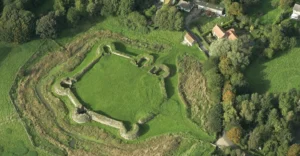
In the heart of Lincolnshire’s scenic countryside approximately three miles from the market town of Spilsby stands Bolingbroke Castle, a site that encapsulates centuries of English history. Built in the early 13th century, this castle has witnessed the rise and fall of dynasties, the devastation of wars, and the passage of eras. From its founding as a noble residence to its pivotal role in medieval and early modern conflicts, Bolingbroke Castle is a landmark of profound historical significance.
The Origins of Bolingbroke Castle
The construction of Bolingbroke Castle began around 1220 under the direction of Ranulf de Blondeville, the 4th Earl of Chester. A powerful and influential noble, Ranulf was a key figure in the Angevin Empire, serving as both a warrior and a statesman. The castle was built to serve as a stronghold, a demonstration of Ranulf’s power, and a centre of governance for the region.
Situated in the small village of Bolingbroke, the site was chosen for its natural defences, with an elevated position that overlooked the surrounding flat countryside. The castle’s design reflects the military strategies of the period, with an emphasis on fortification and functionality.
Strategic Importance of Bolingbroke Castle
In the tumultuous landscape of medieval England, castles were not merely residences; they were symbols of authority and bulwarks against rebellion. Bolingbroke Castle was strategically significant due to its location in eastern England, serving as a key defensive outpost against incursions and unrest.
During the 13th and 14th centuries, the castle played a role in securing the region for the Crown and the nobility. Its position allowed it to oversee trade routes vital for commerce and military logistics. Moreover, it was a centre for local administration, providing a base for governance and the enforcement of feudal law.
Architectural Features of the Castle
Bolingbroke Castle was designed with a hexagonal layout, a structure that was both practical and formidable. Its curtain walls, made of greenstone, enclosed a central courtyard and were reinforced by six towers. These towers were multi-purpose, serving as lookout points, storage spaces, and defensive positions during sieges.
A wide moat surrounded the castle, offering an additional layer of defence against attackers. The gatehouse, equipped with a drawbridge and portcullis, acted as the primary entrance and was fortified to withstand prolonged assaults.
While much of the castle is now in ruins, the remaining structures provide invaluable insights into medieval architectural ingenuity.
Royal Connections: Birthplace of Henry IV
Bolingbroke Castle’s most notable historical association is with Henry IV, born here in 1367. Known as Henry Bolingbroke, he became the first king from the House of Lancaster after deposing Richard II in 1399.
The castle’s connection to Henry IV placed it at the centre of the political and dynastic conflicts of the period, including the Wars of the Roses. The birth of a future king at Bolingbroke elevated its status and linked it indelibly with the history of the English monarchy.
Bolingbroke Castle During the English Civil War
In the 17th century, Bolingbroke Castle found itself at the centre of another significant conflict: the English Civil War. By this time, the castle was already in decline, but its strong defences made it an appealing stronghold for Royalist forces.
In 1643, the castle was besieged by Parliamentary troops, leading to a fierce battle. After enduring heavy bombardment, the Royalists were forced to surrender. Following its capture, Parliament ordered the castle to be slighted—its defences were systematically destroyed to ensure it could not be used in future conflicts.
This deliberate destruction marked the beginning of the castle’s transformation into a ruin.
Decline and Preservation Efforts
After the Civil War, Bolingbroke Castle was abandoned and fell into a state of disrepair. The once-mighty walls were quarried for stone, contributing to local building projects. By the 18th century, it was recognised as a historical relic, and efforts to preserve its remains began in earnest during the 20th century.
Today, the castle is managed by Heritage Lincolnshire as a scheduled ancient monument. Ongoing archaeological studies have uncovered artefacts and structural details, shedding light on its historical importance and the lives of those who lived and worked within its walls.
Cultural Significance of Bolingbroke Castle
For the people of Lincolnshire, Bolingbroke Castle is a symbol of their region’s rich heritage. The site hosts reenactments, educational programmes, and community events that bring its history to life. These activities serve to deepen public appreciation for the castle and its role in England’s past.
Bolingbroke Castle also stands as a poignant reminder of the passage of time, its ruins evoking a sense of both loss and resilience. Its story, from its days as a noble stronghold to its survival as a heritage site, reflects the broader narrative of England’s evolving landscape.
The Future of Bolingbroke Castle
The preservation of Bolingbroke Castle is an ongoing effort. Conservation projects focus on stabilising its remaining structures while ensuring that visitors can safely explore the site. Plans to expand interpretive resources aim to enhance the educational value of the castle, making its history accessible to a wider audience. The site is overseen by Heritage Lincolnshire.
As an important historical landmark, Bolingbroke Castle continues to inspire scholars, historians, and visitors. Its legacy is not only a testament to its architectural and historical significance but also a celebration of Lincolnshire’s enduring connection to England’s past.
Summary
Bolingbroke Castle is a cornerstone of English history, encapsulating the power struggles, architectural advancements, and cultural shifts of the medieval and early modern eras. Its royal connections, role in pivotal conflicts, and enduring presence make it a site of national importance. A visit to Bolingbroke Castle is more than just a journey into the past—it is an opportunity to connect with the stories and legacies that have shaped England’s history.
Discover more from Spilsby Online
Subscribe to get the latest posts sent to your email.







